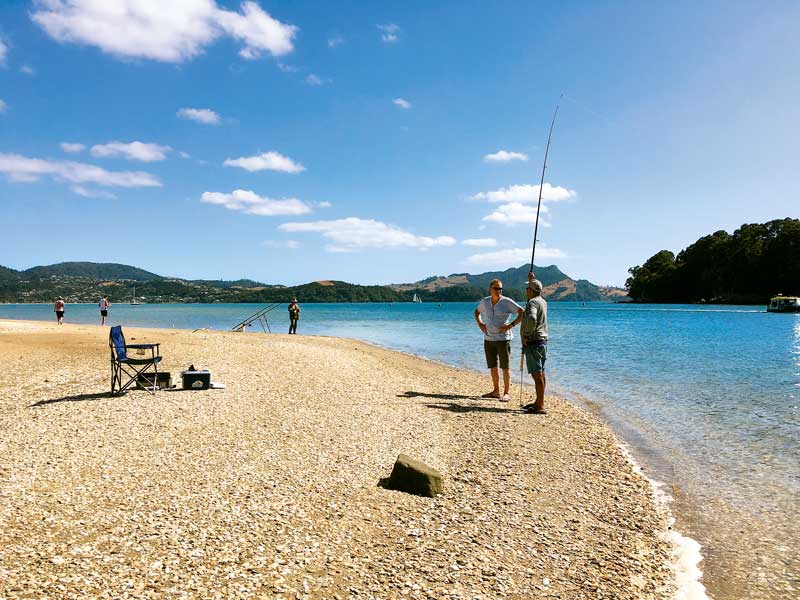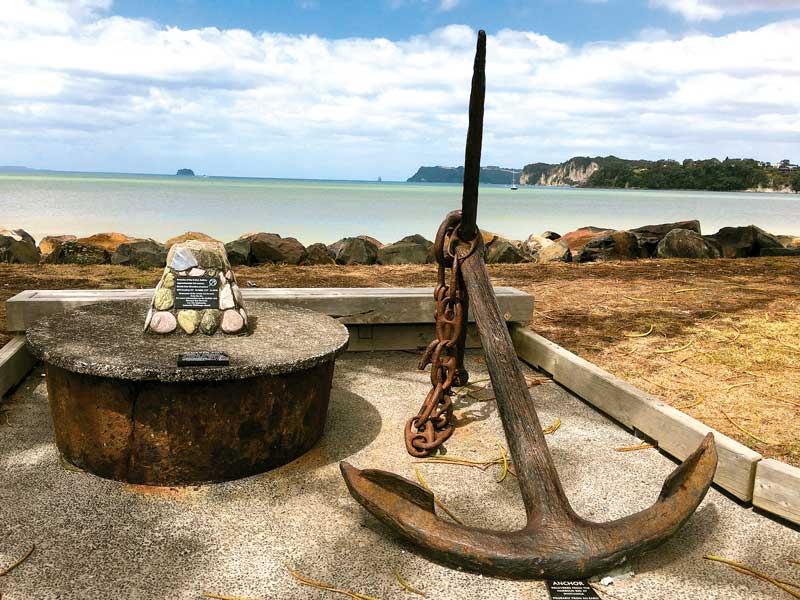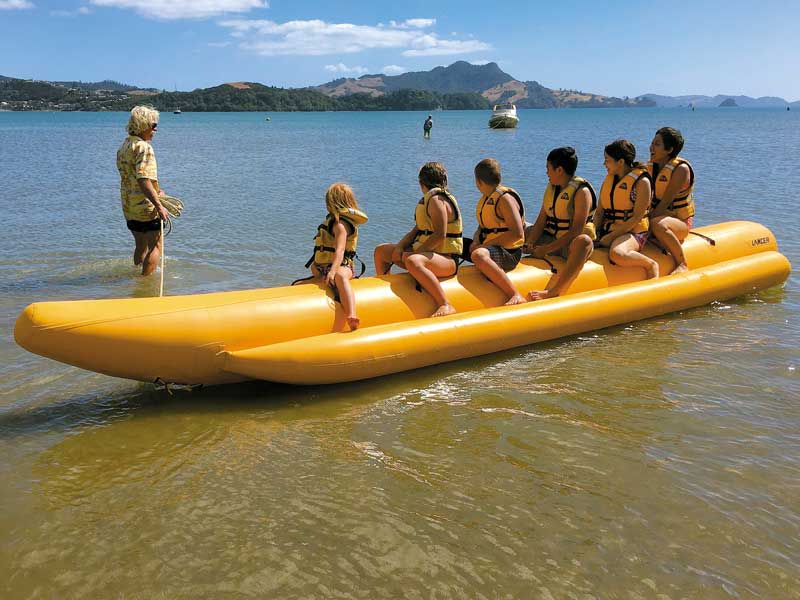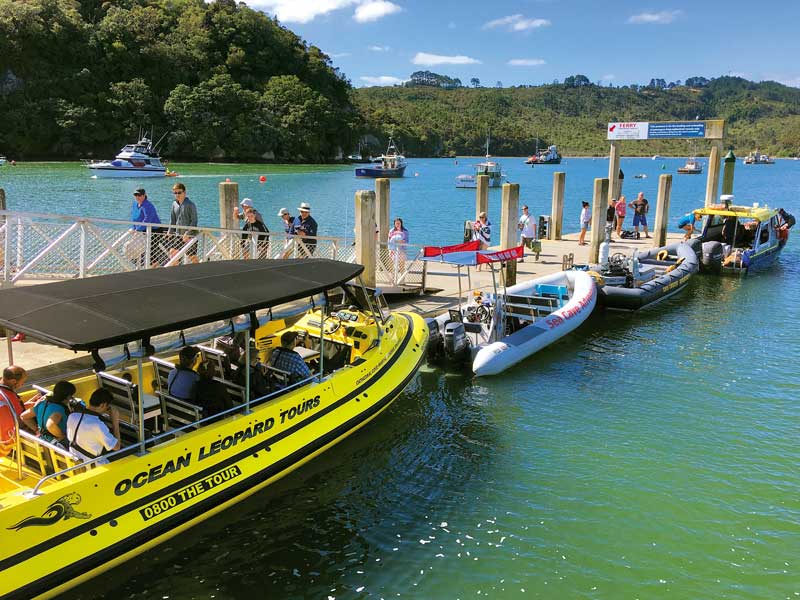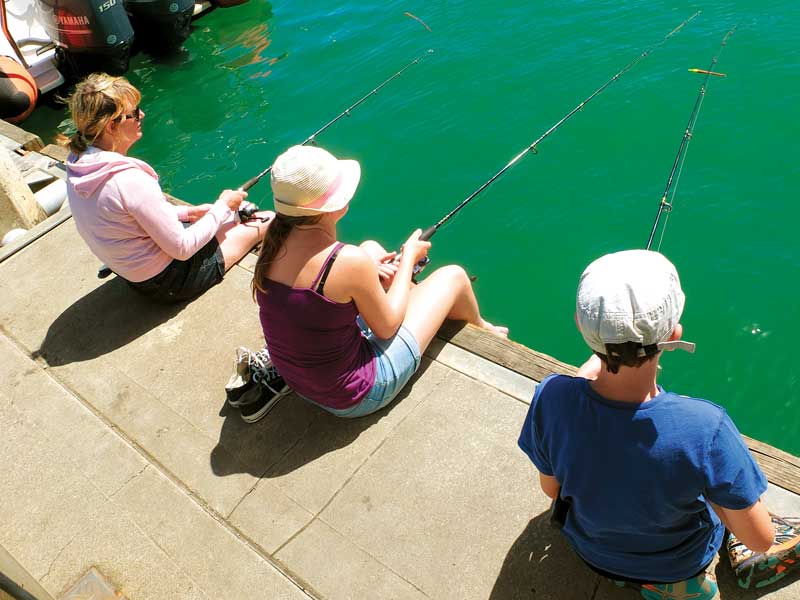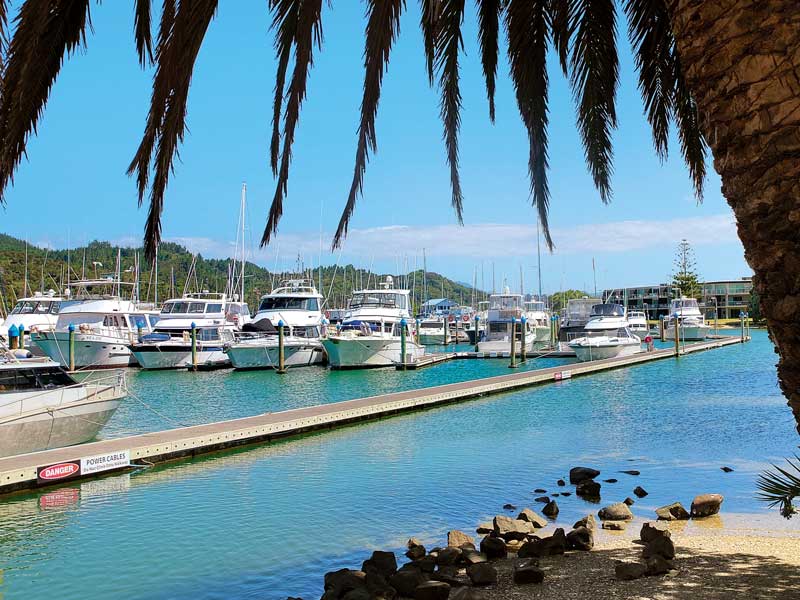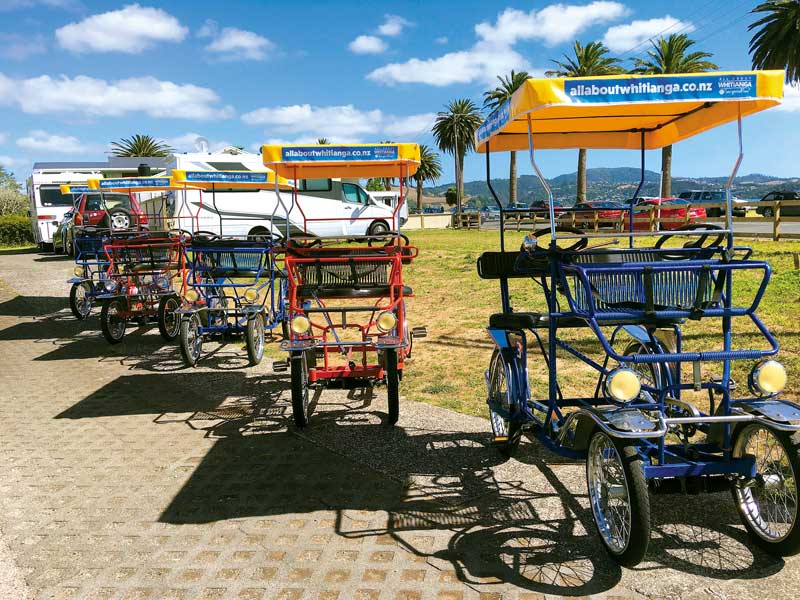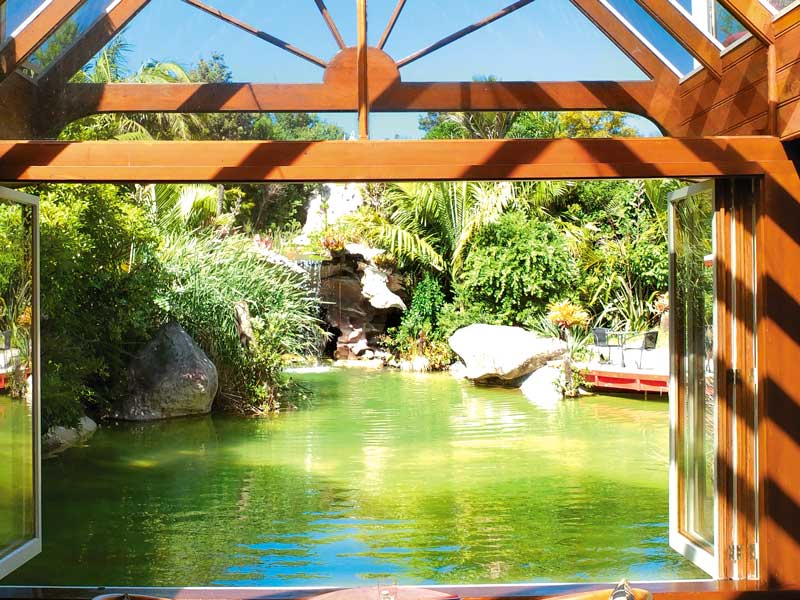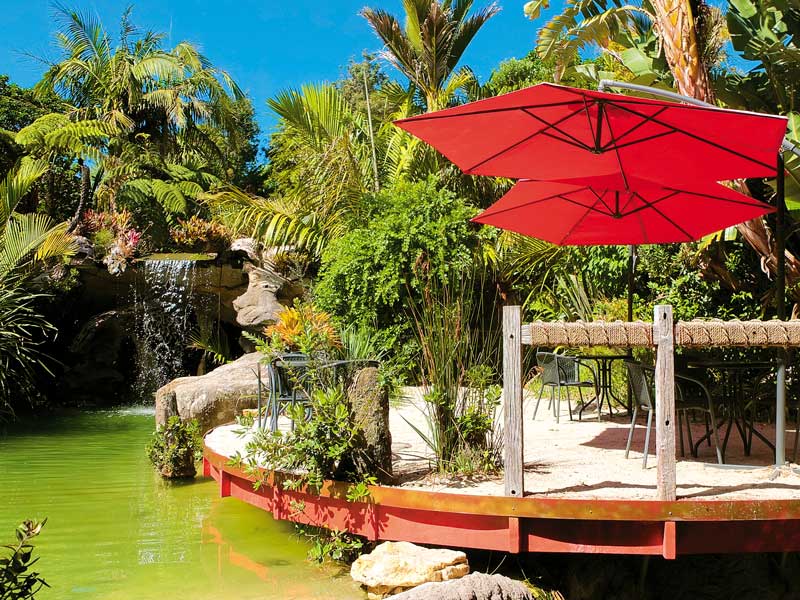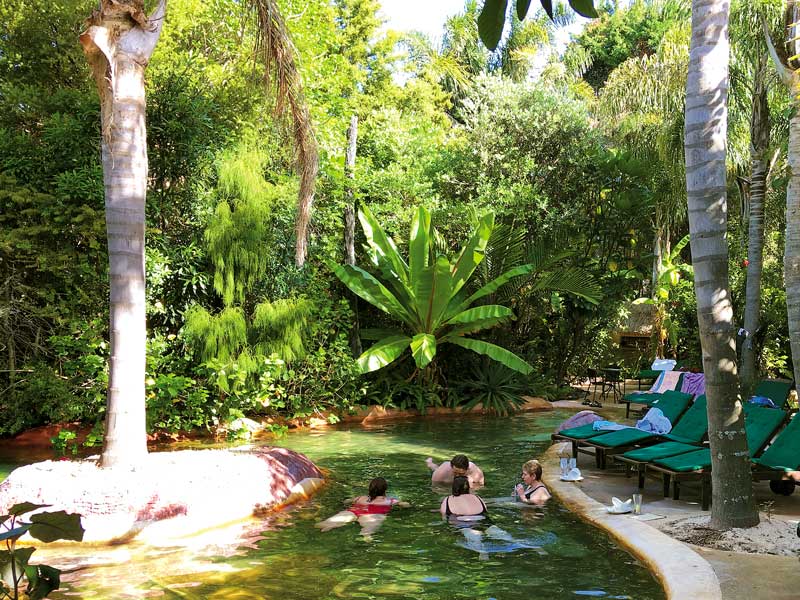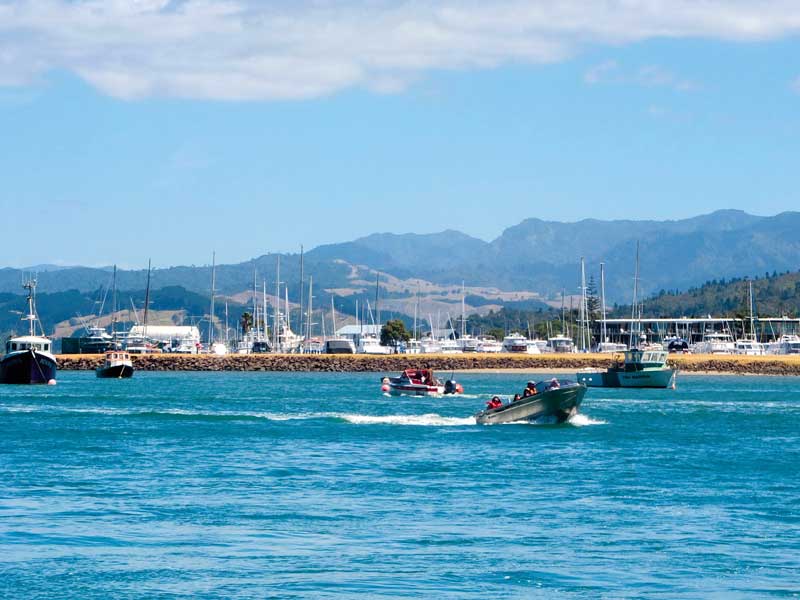On the wooden deck of the Harbour House Cafe, I sipped a tepid coffee and contemplated the nature of this small town on the eastern edges of the Coromandel Peninsula. It was still early morning and there was as little wind as there could ever be beside the ocean and almost no cloud. The sky seemed vast. The sea, winking in the sunlight, slipped away from the beach towards the headlands and hazy islands before melting into the far horizon.
In Whitianga—the largest settlement in Mercury Bay—it’s water that confirms the town’s character and is its greatest appeal. Accommodation, businesses, and cafes acknowledge the connection with names such as Salt, Tides, Jandals, Squids, Hot Waves, and Snapper Jacks. Activities, except for golfing, walking, and biking, are all water-based. Every summer morning at the wharf, people trip down the ramp to board the inflatables, the launches, the glass-bottomed boat, or the racing-grade catamaran that takes them out to sea.
It’s not exactly ‘down to the sea in ships’ but there is a similar expectation of adventure ahoy.
Most expeditions set off around the point, past cliffs as white as newly brushed teeth, to head for Cathedral Cove, Cooks Blowhole, Champagne Rock, the Orua Sea Cave, and Te Whanganui a Hei, the marine reserve established in 1992. Others follow Mercury Bay’s striking northern coastline.
Next to the Whitianga wharf, an extensive marina is crammed with gleaming launches, many of them privately owned but some available for fishing charters. The craft were too many to count and the number attests to the popularity of boating, fishing, and diving in Mercury Bay.
DIVING In
Deep-sea fishing and diving boats go as far as the Alderman and Mercury Islands. Across the road from the wharf is the Mercury Bay Game Fishing Club. I can’t say much about it, as it was closed. I don’t want to foul up fishermen’s fun but I don’t hold with deep-sea fishing, even if it is tag and release. This is partly due to my own guilt. Years ago, I caught a marlin in the Bay of Islands. It shimmied out of the water, leaping high in the air, trying to save its life. It was a majestic creature whose beauty took my breath away. It was killed and hung by its tail, and I still feel damned by that slaughter.
I am happy, however, to promote deep-sea diving. Divers have deep connections with the ocean and a desire to keep its creatures alive. Whitianga is the hub of diving locations on the Coromandel Peninsula, with a myriad of islands and secluded bays that will leave you spoilt for choice.
I went to Dive Zone, where both expert and aspiring divers book underwater adventures. My own aspirations were limited. I just wanted to look at the pictures on the walls. Just for interest, I sussed out the diving trips with Dive Zone owner Darrell Bird, who curiously had done his own dive training in the Red Sea. “Maybe, you’d prefer a kayak,” he said, no doubt observing my age. “There’s good kayaking in the harbour and the Waiwawa River. You can go right up to Coroglen from here.”
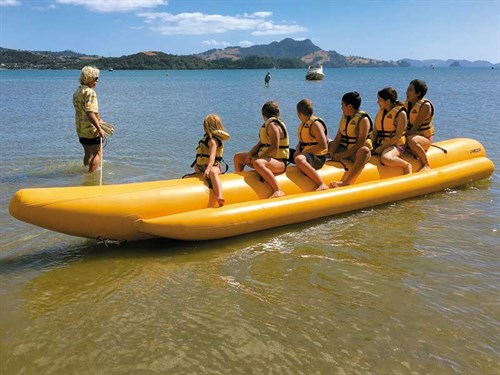
He showed me the route on a wall map. I felt chuffed that I looked like someone who could paddle that far. From 1884 to 1913, a steamboat called Little George used to ply this route carrying passengers and supplies from Whitianga to Coroglen. In those days, roads in the area were almost non-existent.
Darrell pointed to another stretch of water, the short channel between Ferry Landing and the Whitianga wharf. “Get down there sometime when the tide’s changing,” he said. “The water gets up amazing speed.”
ALL ABOARD
And so that evening, I sat tide-gazing on the dock of the bay, as the water ripped through the narrows that join Whitianga Harbour to Mercury Bay. The only way across this short stretch of water is by boat.
It’s easy enough aboard a cute little ferry called the Mercury Star, which leaves and returns every 15 minutes or so. A return trip costs six dollars. As it puttered across the water with me aboard, I contemplated the many years that ferries of some sort or other had made the same run.
Mercury Star docked at Ferry Landing Wharf, of which there is not a lot to be seen except for large stone steps and a wall of hewn stone blocks. This is not surprising as the wharf was built in 1837 and is thought to be the first stone wharf built in Australasia.
From there a short uphill walk leads to a cafe and then on to the spectacular Flaxmill Beach and Lonely Bay. In summer, a bus waits at the landing and delivers the less energetic to the other places that make this area so desirable, such as Cooks Beach, Cathedral Cove, Hot Water Beach, and Hahei.
Apart from the ferry trip, I did not join the seafaring set this time, exploring the town instead from a landlubber’s perspective.
Along the waterside, starting at Whitianga Wharf is a paved, five-kilometre walk/cycleway that follows the contours of Buffalo and Brophy’s Beaches.
One or two fishermen were trying their luck at the water’s edge and a constant pageant of leisure craft bustled to and fro. Further along the track, a group of children had just climbed astride the Banana Boat, a strange, yellow, inflated tube, which when towed at speed behind a boat, provides a watery thrill. Two men, looking tentative and uneasy, wobbled past on paddleboards.
STEPPING BACK IN HISTORY
About half way along Buffalo Beach is a large embedded anchor and a monument that explains the rather incongruous name and some fascinating history. Few towns have had one of Her Majesty’s ships delivered so dramatically to their doorstep. In 1840, the sailing ship HMS Buffalo, after conveying its convict cargo to Australia, arrived in Mercury Bay to collect kauri spars. She was seeking shelter from a fierce gale behind the rocky point opposite Whitianga, when a mighty wind gust, coupled with an outgoing tide and a titanic swell, forced her onto the beach where she foundered. Remains of the wreck, just 220 metres offshore, can still be seen from the air.
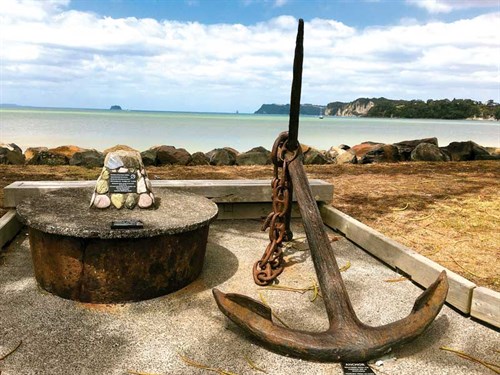
The day I walked the beach, it was difficult to imagine that calamitous event. The sea was so calm it looked like cellophane. Back in town, the Whitianga Museum, housed in an old dairy factory, documents the drama in detail.
Another snippet of history along the walkway lies in a small, plain, cream-coloured structure that is the Mercury Bay Boating Club. From this modest building, in 1987, New Zealand delivered its first challenge to the yachting heavyweights of the world for the Americas Cup.
A GROWING TOWN
Whitianga has a population of around 4000. But that could be old news. It is expanding at a fast rate as escapees from larger cities seek its laidback style. Drive along Kupe Street and the size of new subdivisions becomes apparent. So too does the ambitious development of the canals. Already, this huge project—which provides each house section with its own boat mooring—is one-third of the way through its development. Eventually, the company, Whitianga Waterways Ltd, will have created 1300 to 1500 sections and this will effectively double the size of the town. To walk down the lawn from your house and climb aboard your own boat must be almost as good as having your own motorhome parked in your driveway.
FINDING THE LOST SPRING
When I finally took to the water in Whitianga, it was not by boat. I swam at the glorious Flaxmill beach and then one evening, when the temperature had cooled, Bill and I found the Lost Spring. This amazing place, tucked away behind the beach frontage, is another world. It is like walking into a fairy tale among tropical foliage and a maze of paths, caves, waterfalls, rocks, and quietly steaming pools. I could have easily imagined I was on some sort of fantasy island.
Of course, it wasn’t us who found the spring. In 1980, Alan Hopping, a former dairy farmer, invested in a Whitianga camping ground. Fascinated by the rumours of a hidden thermal spring on the property, he eventually sank a test hole that a water diviner had indicated might be the spot. The hunch was correct. They were soon in hot water. Even better, it was full of minerals and sparkling with promise. It took Alan and his wife 10 years to design and build the elaborate pool complex and the tropical gardens that are there today. The spa, bar, and restaurant, reminiscent of a high-end tropical resort, is in the old Whitianga schoolhouse that was moved to the property and renovated.
There are several pools of varying temperature and we tried them all. Then we parked ourselves in chairs on the deck and sipped tropical cocktails under bright red umbrellas and agreed that Whitianga wasn’t too bad a place at all. Perhaps we could move there.

